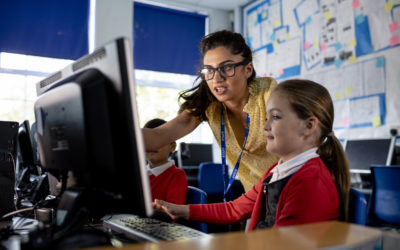Computational thinking has become important to teaching problem solving in education because it empowers students with processes to develop strategic solutions to complex problems, essentially “leveling up” their skills, or creating algorithms that can make future processes more effective. This enables students to take on more complex challenges and prepare for real-world applications.
Decomposition in Computational Thinking
While the process of computational thinking is multifaceted, there is one key to computational thinking that is essential for success: decomposition. Decomposition is the process of breaking a complex task or problem into smaller, more manageable pieces. From this decomposition, students can eliminate unnecessary information, identify patterns and begin the process of identifying which parts of the problem are most important, how to solve or complete each step, and how those parts can be put together for a clear and unified step-by-step solution.
Why is the Decomposition Technique Required in Computational Thinking?
The technique of decomposition is required in computational thinking because it breaks complex tasks into subtasks while developing a sequentially-based understanding of the problem. This allows unnecessary information to be discarded, patterns to be identified, relevant information to be extracted and the process of step-by-step resolution to be defined for a more effective problem-solving process.
By definition, computational thinking is the process of tackling complex problems and finding a clear, step-by-step solution that can be replicated. Decomposition, therefore, is essential to this process as it includes breaking a task into several sub-tasks, helping to align the task to a step-by-step solution.
Another reason decomposition in computational thinking is important is because it allows each subtask to be examined more closely. This not only helps to categorize information as essential or non-essential, but also empowers the problem-solver with a better ability to analyze each specific part of the task or challenge to more effectively develop a reasonable solution.
Examples of Decomposition in Computational Thinking
Below are some real-world examples of utilizing decomposition in computational thinking:
- You have to clean your house. Instead of facing the task as a whole, you practice decomposition by breaking the task into a to-do list with multiple subtasks.
- To build shelves for a storage space, you practice decomposition by measuring the space, creating a blueprint or plan to determine the size of the shelves and the materials you need to accomplish the task. Next, you purchase the supplies and cut the lumber to size, then install one wall of shelves at a time.
- In science, to prove or disprove a hypothesis, you practice decomposition by creating subtasks including background research, observation, generating a hypothesis, determining which variables to test, performing experiments and drawing a conclusion.
Final Thoughts
Consider how often computational thinking appears in your everyday life. Do you naturally use decomposition and computational thinking to resolve a challenge? For more information about computational thinking and how they apply to students, explore some of our most recent articles:
EasyTech Wins Tech & Learning Awards of Excellence: Best of 2022
We’re excited to share that Learning.com’s EasyTech has won in this year’s Tech & Learning Awards of Excellence: Best of 2022 in the Primary Education category. The awards celebrate the best products in the education technology industry from the last 12 months....
How One School District is Driving Digital Wellness in Students (& How to Join)
Technology is undoubtedly a fixture in students’ lives. For them to use technology responsibly, safely and effectively, they need to understand the impact of technology on their lives and develop strategies for navigating the digital world. Hilliard City Schools, a...
What is Digital Literacy: Definition and Uses in Daily Life
Digital literacy encompasses the skills required to use technology safely, effectively and responsibly. As technology continues to become more and more ingrained in daily life, the importance of learning digital literacy skills is becoming increasingly apparent. What...
Texas Technology Standards: Big Changes Need Big Solutions
Texas schools have big changes on the horizon when it comes to digital skills. This year, our Lone Star students will be required to take their statewide assessments online for the first time ever. Then, we’re gearing up to implement revised Technology Application...
Definition of Computer Science, Computational Thinking and Coding
Your alarm on your smart phone wakes you in the morning—that’s powered by computer science. You ask your smart speaker what the weather will be that day—that’s also powered by computer science. You order coffee on the Starbucks app on the way to school—you guessed it....
Year in Review: 2022
2022 has been an exciting year at Learning.com! We served content to more students this year than ever before, reaching around 1.5 million students with 50 million content launches! We work with schools in every state of the nation and this year even welcomed a few...
Why Should Teachers Integrate Technology in the Math Classroom?
The image below reflects a workflow that Keith Devlin, a retired mathematics professor from Stanford University – uses when he is working on solving a math problem. In his experience, many mathematicians have similar workflows.Let’s say he is working on solving a new...
Online Holiday Safety Tips for Students
During the holiday season, you may find more opportunities to be online than during other times of the year. You may also take and share more photos with friends, make more online purchases, or stream more videos as you relax at home with family. There are several...
Behind the Scenes: Developing Meaningful Educational Videos
Creating videos that are educational, engaging, and entertaining is no easy task. The illustrators at Learning.com make it look easy, so here is the inside scoop on how they make it happen! The role of the illustrator is to bring a whole world to life. Making a...
The Comprehensive List of Important Digital Skills for Students
The digital skills gap impacts Americans of all ages. If lacking basic digital skills, students will face challenges not only in school, but in the professional world as well. Students require digital skills to perform research and produce projects in school, as they...
Why is Computer Science Education Important?
Computer science education is important for preparing students for the future of work. By teaching students about computer science, schools work to fill an inadequate pipeline of computer science graduates and workers, build digital skills that are expected of workers...
When Should Children Start Learning Keyboarding?
When parents or grandparents say that their children or grandchildren can use technology better than they can, they’re usually only half joking. After all, it seems children of nearly any age can quickly figure out how to navigate most digital devices, such as...

Learning.com Team
Staff Writers
Founded in 1999, Learning.com provides educators with solutions to prepare their students with critical digital skills. Our web-based curriculum for grades K-12 engages students as they learn keyboarding, online safety, applied productivity tools, computational thinking, coding and more.













